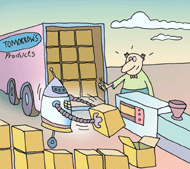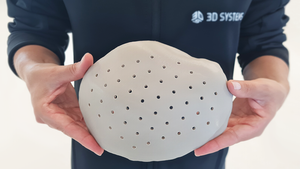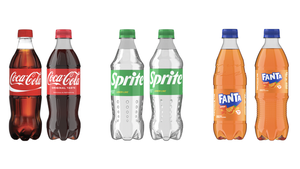May 29, 2000
 Benjamin Franklin's advice to a young tradesman in 1748 was, "Remember that time is money." These days, as the Industrial Revolution transitions to the Information Age, most of those involved in the injection molding trade are reminded of Franklin's sage advice 24/7. Time is money today, and both of these equally precious commodities are running out.
Benjamin Franklin's advice to a young tradesman in 1748 was, "Remember that time is money." These days, as the Industrial Revolution transitions to the Information Age, most of those involved in the injection molding trade are reminded of Franklin's sage advice 24/7. Time is money today, and both of these equally precious commodities are running out.
Some customers have stated that their goal is a 10-day OTD-and guess who they want to pick up the tab for tooling? Others want upfront product development help for free. Some pay lip service to the importance of quality, and then tie up molders with time-consuming and sometimes meaningless in-process and quality revalidation paperwork.
Other customers have talked themselves hoarse about building long-term relationships with a small number of strategic supplier/partners with the wherewithal to add value to products. Then these customers threaten to level the playing field by auctioning off jobs to low-ball bidders, worldwide, on the Web, prioritizing cost over value.
Molders contacted for this article agree that the complex and changing nature of today's business climate is altering injection molding. All agree with Hoop Roche, president and ceo of Erie Plastics in Corry, PA. He says the changes will impact much more than just the manufacturing shop floor.
"What's the biggest challenge we face? The answer is everything!" Roche half jokes. "In reality, the answer probably is coming up with a strategy that enables our companies to survive financially given the market dynamics of the current economy."
Mindful of Franklin's advice, Roche and others hope that their manufacturing strategies will help make even more efficient use of machine time, all the while reducing costs, generating savings, and improving margins. Still, these changes pose many challenges, not the least of which is the challenge to change.
Innovation Is a Hard Sell
"You know, we have come a long way in the past few years. The machines are there, toolmaking equipment is there, better process control equipment is getting there-though not fast enough. But, as an industry, we fail to stand behind our own ideas at times."
'Speed is what everyone is looking for now, and I mean ramping up—speed to volume.' |
Many may agree with this basic assumption of Coburn Pharr, global operations manager at Molex Inc. in Harvard, MA. The injection molding process, in and of itself, is essentially unchanged, posing the same basic challenges. Machinery suppliers and moldmakers have done well in keeping pace with market demands through innovative new products.
But there have been many advancements that the industry itself-including molders, their customers, and their suppliers-has failed to capitalize on.
"Take lights-out molding-what a terrific concept," Pharr offers as an example. "Yet, we've never been able to get high-end customers to buy into it. They still want all of the old inspection techniques of 10 years ago. No one will loosen up. It was a bad selling job, indeed."
Table 1 |
In February NAM announced the results of a broad-based nationwide poll the organization conducted. The majority of poll respondents, 68 percent, said their companies are not using B2B e-commerce. The 32 percent using e-commerce said they use it for the following purposes: |
• New product introductions |
• Shop for the best pricing |
• Use in place of EDI |
• RFP/RFQ/RFI |
• Buy intermediate materials, parts, |
• Arrange logistics |
• Buy raw materials |
• Integrate existing supply chain |
Rick Hoeske, vp of engineering at Nypro Inc. in Clinton, MA, largely agrees with Pharr's assessments, adding that many multinationals are still requiring inspection and validation procedures that are too cumbersome and time consuming for suppliers like Nypro, which transfers projects and equipment between its sites. Hoeske says Nypro is working on systems and approaches to verifying processes, and is using statistics and process control to minimize the qualification and reevaluation of both products and equipment.
"I guess we still need to come up with a better way to transfer projects and equipment between our sites with a more reliable verification process, so that we can minimize customer revalidation," says Hoeske.
E-molding challenges |
The application of computer technology is generally regarded as the most influential innovation in the injection molding process since the development of the reciprocating screw. Stephen L. Sinderson, vp of operations at Woodland Plastics Corp. in Addison, IL, believes that one of the biggest challenges facing molders is the resistance to change, especially when it comes to computers. Many share Sinderson's vision of the factory of the future that could help save time and money: open-architecture controllers running fully integrated shop-floor equipment with production/process monitors networked into Internet-enabled production planning and accounting systems. Yet, Sinderson says probably less that 1 percent of all molders today have reached the state of this art. "Many molders have yet to get Web access, and many have not even given a thought to networking their facility and gathering data from the shop floor for analysis," he says. A major challenge has been the lack of communication standards for sharing information between different vendor's machines. Most suppliers only offer proprietary, closed-architecture factory automation solutions. Collaboration and Communication Computers, providing shop-floor connectivity and Internet access, are powerful tools for collaboration and communication among molders, suppliers, and customers. They would enable quicker and better collaborative forecasting, inventory planning, and new product development, according to Sinderson. However, most molders resist using B2B e-commerce. "No one questions the importance of B2B e-commerce, yet relatively few manufacturers are participating in it," says Jerry Jasinowski, president of the National Assn. of Manufacturers (NAM) in Washington, DC, which recently conducted a B2B usage survey (see chart). "The simple fact is that industry has to do better." Sinderson believes that molders must overcome their resistance to change and increase their spending on IT systems from today's average of 2 percent of gross revenues to 4 to 6 percent, if they hope to cash in on B2B e-commerce sales, which are expected to reach $1.4 trillion by 2003. |
Materials Challenges
Molex's Pharr accuses some materials suppliers of failing to promote key technical innovations that could better help molders meet time and money challenges. "[One is] inline rheology of plastics material manufacturing, for instance," he says. "I cannot believe that plastics suppliers are not obligated to lead by example in this area. No one is really carrying the flag on this issue. The technology is there. The excuses are, as well.
"GE, Dow, DuPont, etc., shame on you! We should expect this type of inspection on the so-called 'premium' products supplied by companies such as these as at least a minimum service. We, as manufacturers, deserve the right to know manufactured-in process control information of materials on a rheology level lot by lot."
Pharr also says materials suppliers cause manufacturing challenges by failing to provide a better means of evaluating materials for specific product applications. Plastics materials databases should be more fully integrated into design software, he says. "I know some of this is happening. However, the activity is not formalized. The number of materials on the market today, and the number of materials utilized or tested to understand their value continues to concern me. There are so many materials and no real plan in place to link them with popular design databases in the marketplace."
He adds, "We have all of these great properties identified but no real commitment by the material suppliers to improve the details reported. Rarely do I see the same information detailed or available from one material to another on databases supplied by the resin manufacturers."
Machinery Challenges
Robert Beesley, manufacturing engineer at the Packard Electric Div. of Delphi Automotive Systems in Warren, OH, has a somewhat different twist on the challenges molders face when choosing from an overabundance of products.
"The biggest challenge I see to the industry at large is in determining which manufacturing technology is most applicable to a specific type of product," he says. "There are so many enhanced controls and new system technologies emerging, it is just as easy to jump into something that does not apply to what you really want to do, as it is to misapply any one of the many technologies available today."
Delphi-Packard Electric is fortunate enough to have the resources to perform extensive internal reviews and cost analyses to evaluate different machinery solutions when tackling new projects. Beesley believes the review process has enabled the company to push the envelope in applying emerging technologies, like gas assist.
However, many other molders lack the time and money to perform such in-depth studies. Everyone wants manufacturing cells, believing, as does Nypro's Hoeske, that integrating the molding machine with secondary operations, like assembly, is a key cost-reduction trend. But choosing the right cellular systems can be a daunting task, especially when molders are faced with another big future challenge-the need for speed.
"Speed is what everyone is looking for now, and I mean ramping up-speed to volume," Hoeske explains. "An even closer loop between the end user and the supplier is what is needed. 'Early supplier involvement' . . . we use these words all the time, but it is not really being done the way it should be.
"There must be ways to improve upon the process of ramping up on projects. Before, it was just a matter of how fast you could get a prototype part to look at, or how fast you could build the mold. But now it is a question of how fast you can get high-volume production up and running, often in multiple locations."
Talk to us |
Now tell us how you cope. What have you done to meet your challenges? Please answer one or all of the following questions and fax to Jeff • What have you found is the best method for enhancing productivity? • What strategies do you use to keep operators and other personnel up to speed on the shop floor? • What new processing technologies excite you the most, and why? Please include your name, company name, and phone number. |
Training Challenges
As the 21st Century dawns, the biggest challenge molders say they face is as old as the basic challenge of molding a good part: training. The manufacturing buck and the manufacturing clock stop here.
Controlling heat, pressure, flow, and cooling-that is basically what the molding process has always been about. Some molders think (hope) that people will magically appear, fully trained in these basics. And when such dream employees don't show up, molders wonder where they can be found. Other molders complain of the downtime and overhead associated with training newcomers. And some fear that they will spend time and money training employees, only to have them kidnapped by competitors.
Still, everyone complains about the challenge of finding trained people, and there is no reason to expect the volume of such complaints to decrease. Molex's Pharr says training is imperative for more than just basic process engineering. "There must be better training in mold design, plastics engineering, operations, general management, everything-most of all in toolmaking."
Pharr concludes by calling on molders to face the challenge of learning how better to sell their organizations and manufacturing capabilities to customers. "We need better, industry-specific training on items related to sales and marketing successes," he says. "The industry is not savvy in this area. There is more to a successful company than a colorful brochure."
In the end, the molding industry right now is changing fast and unpredictably. The greatest challenge in front of molders is building and maintaining a manufacturing organization that has the strength, resilience, and flexibility not only to sell itself well, but also to take advantage of the opportunities such changes present.
You May Also Like


